I’ve seen lots of questions here and elsewhere about how to go about building and putting wire antennas in the air. For the most part they have been good questions, and we all had to start somewhere. Bear in mind there are many ways to skin this cat, but let me offer a low tech and low cost way to go about this.
If all that is required is a way to support a wire antenna, consider a wooden mast. The one big disadvantage of a wooden mast is weight. Compared to steel, fiberglass, or aluminum, wood is just plan heavy, and there’s no way around that. But it’s also pretty cheap, which is a huge factor in its favor. If you go back through the ARRL manuals and antenna handbooks of decades past you’ll see lots of examples of wooden structures, including the famous A-Frame antenna mast that was probably duplicated thousands of times.
This approach is considerably simpler, and you don’t have to do what I’m showing here, but perhaps this will help get the wheels turning and give you ideas to incorporate into your own antenna farm.
My own situation is this: An 80/40 trap dipole supported by a large pine tree at 55’ on one end, and a wooden mast on the other. The overall length of this antenna is 105’ 2”, though this approach will work for any horizontal wire antenna. The first mast I built was damaged in the terrible storms we had here in Alabama in April of 2011. You may have seen the news accounts of the awful tornados we had in the Tuscaloosa and Birmingham area on April 27th—but what you probably don’t know unless you live here is the 100+ mph straight line winds we had that morning just before daylight for a half hour—which is understandable given the horrible destruction and loss of life than came later that day. But what I’m showing you here survived those terrible winds in the dark and though I was without commercial power for 5 days (my portable generator was the power grid for my house and 4 of my neighbors that week), my antenna and feedline survived.
This mast, as the one it replaced, is two 14 foot 2x3s spliced together with 3-½” deck screws. Here the mast is already painted to blend in with the trees along my back fence:
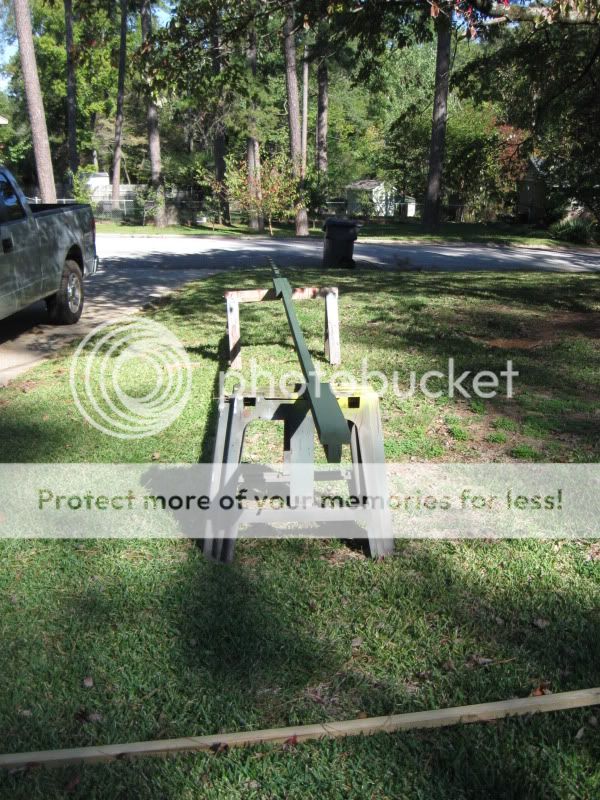
I bought the lumber as 2x4s and there’s nothing wrong with using 2x4s, but ripping them to 2 ½” wide boards cuts down noticeably on weight. The pieces at the joint are both 3’ long—treated lumber was used for the lower piece to avoid decay and termites, yellow pine for the upper piece. Total cost for the lumber at Lowes was about $12.
1/8” nylon line was tied to each end insulator, which was run through pulleys on each end. I had trouble with the line binding on the original pulley, and opted for a larger one this time. The original pulley is shown here at the top with the wall pulley (about 4 bucks) I used this time below:
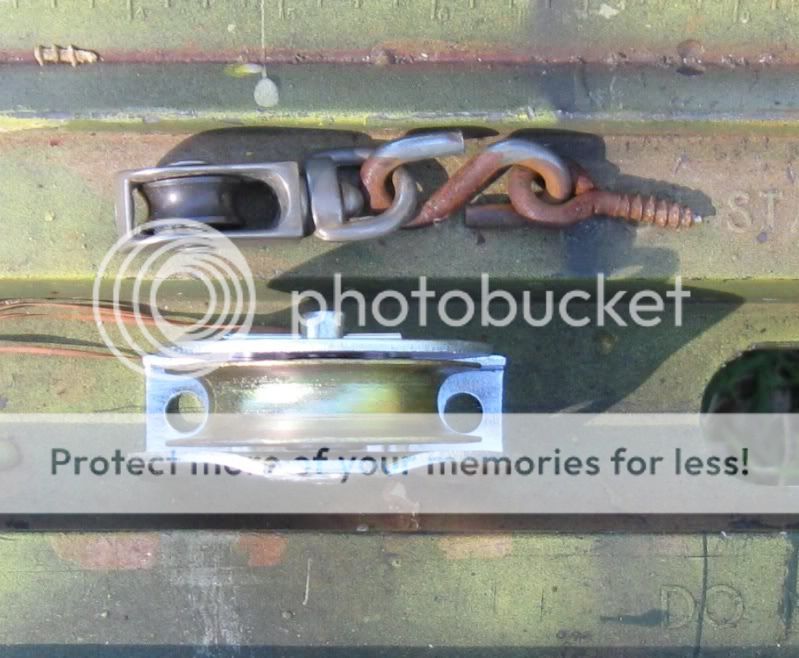
On the first 2x3 mast I used large eyehooks for guy attachments. One of them pulled out during the storm, and I opted for eyebolts and lock washers this time—shown here with the new ropes (the old ones were retired after 6 years of UV exposure) tied to the eyebolts with bowline knots:
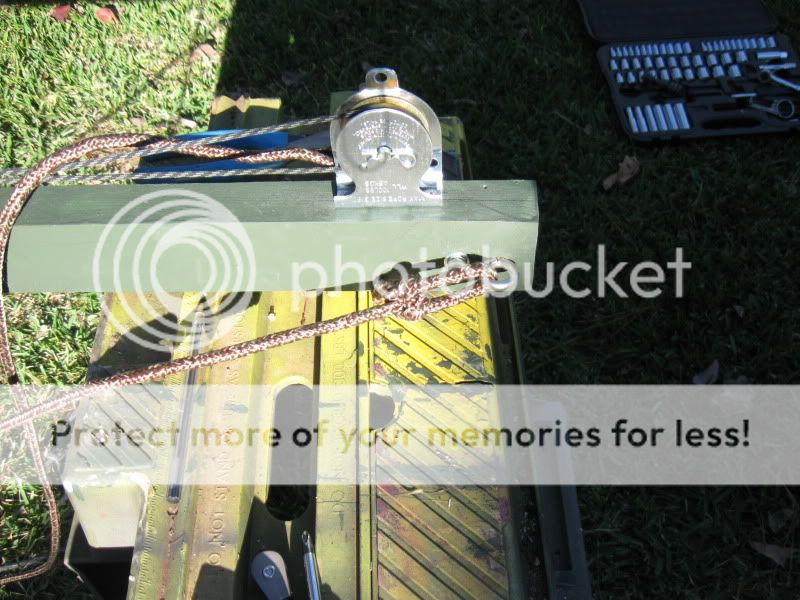
The mast was seated in a 20” hole—nothing scientific about that, I just got tired of digging. It probably should have been deeper but I live on a mountain and the dirt gets hard pretty quickly. Once I had it as level as I could get it (just dirt, no concrete) I hoisted the dipole up into the air:
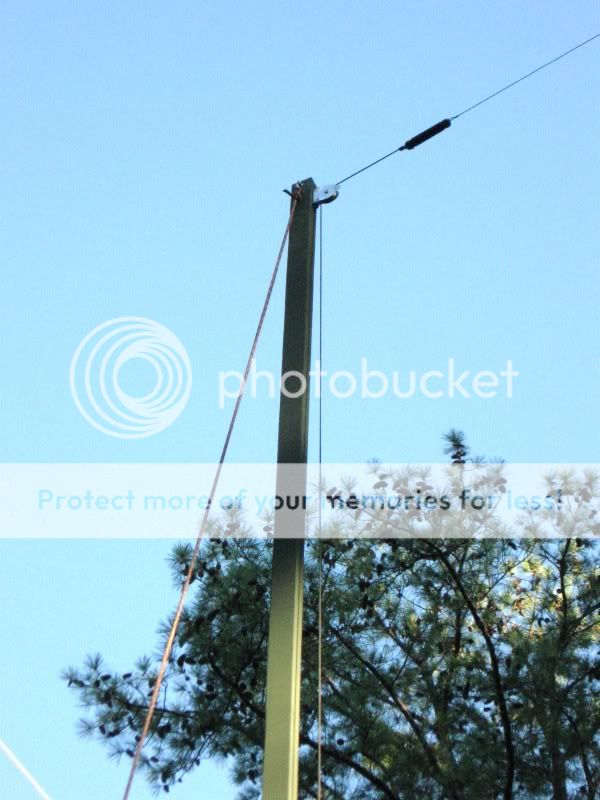
I only have the two guys coming off the rear to counter the force of the antenna coming from the front, and trucker’s hitches helped me jockey back and forth between the two to straighten things up.
What I think really has been the key to this antenna’s survival is what’s at the other end. If you look closely, there are two lines coming down from the pine tree. This is at 55 feet—one goes across the limb and down, the other goes through a pulley attached to that other line and down.

The line crossing the limb is a 3/8” rope which is tied off to a cleat I made from scrap wood and attached to one of those screw-in pet tie down things:
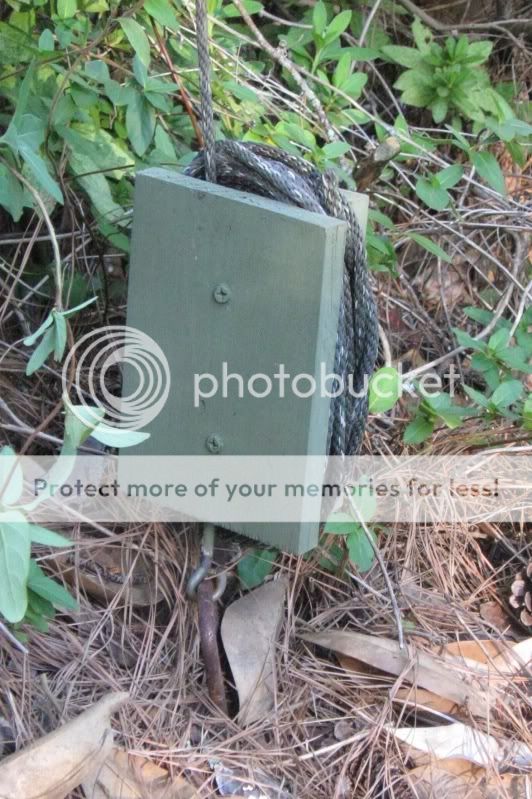
That line is fixed and moves with the tree. After six years in this configuration there is some UV damage but no fraying.
The other line is a 1/8” cord tied to the end insulator of the dipole. It is tied off to another homebrew cleat which has a spring between it and another screw-in anchor:
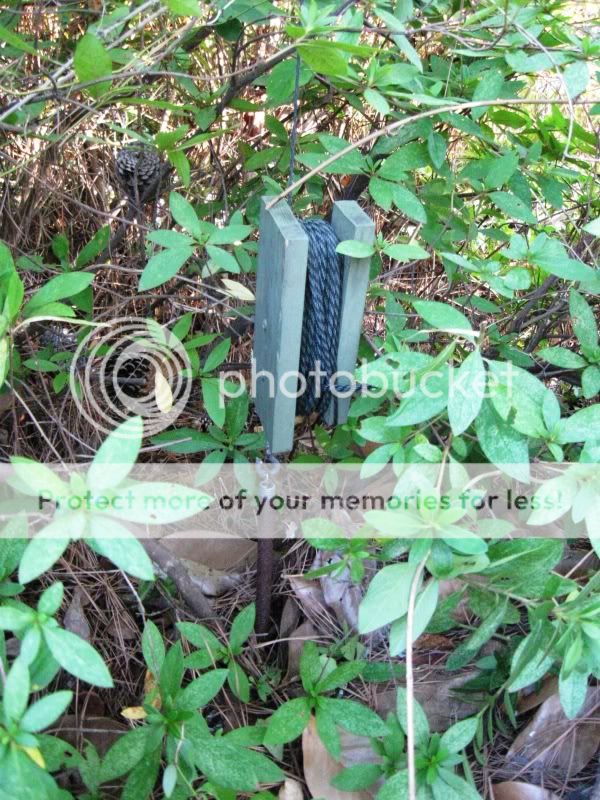
The spring is rusty now, but the idea is to pull on the spring and have it stretched a bit when the cord is tied off. What this does is keep antenna in suspension so that the spring can extend or contract, no matter which way the tree branch moves.
In case anyone is curious, here’s the feedpoint of that antenna—a Unadilla 80/40 trap dipole to which I added 20 and 10 meter dipole:

You can see the middle wire (18 ga solid) is still bent a bit from that storm, but on a morning when many of my neighbors had 150 foot visitors in their living rooms and their cars smashed to bits, we were very fortunate—you have to figure that when shingles and pieces of insulation are falling from the sky 45 minutes before the real storm gets to you, it is not going to be a good day.
There have been many times I’ve gone outside after major wind and ice on this mountain (such as the storm that killed my 20/10 meter yagi) and expected to see a limp piece of coax lying in the yard with maybe 5 feet of wire left hanging from a tree branch, yet this antenna has survived some really nasty stuff and kept on tickin’.
So, consider using a wooden mast and think about the screen door spring trick if you’re considering a wire antenna. I certainly didn’t invent these ideas, but sometimes Old School and Cheap fits the bill just fine.
73,
Rick
If all that is required is a way to support a wire antenna, consider a wooden mast. The one big disadvantage of a wooden mast is weight. Compared to steel, fiberglass, or aluminum, wood is just plan heavy, and there’s no way around that. But it’s also pretty cheap, which is a huge factor in its favor. If you go back through the ARRL manuals and antenna handbooks of decades past you’ll see lots of examples of wooden structures, including the famous A-Frame antenna mast that was probably duplicated thousands of times.
This approach is considerably simpler, and you don’t have to do what I’m showing here, but perhaps this will help get the wheels turning and give you ideas to incorporate into your own antenna farm.
My own situation is this: An 80/40 trap dipole supported by a large pine tree at 55’ on one end, and a wooden mast on the other. The overall length of this antenna is 105’ 2”, though this approach will work for any horizontal wire antenna. The first mast I built was damaged in the terrible storms we had here in Alabama in April of 2011. You may have seen the news accounts of the awful tornados we had in the Tuscaloosa and Birmingham area on April 27th—but what you probably don’t know unless you live here is the 100+ mph straight line winds we had that morning just before daylight for a half hour—which is understandable given the horrible destruction and loss of life than came later that day. But what I’m showing you here survived those terrible winds in the dark and though I was without commercial power for 5 days (my portable generator was the power grid for my house and 4 of my neighbors that week), my antenna and feedline survived.
This mast, as the one it replaced, is two 14 foot 2x3s spliced together with 3-½” deck screws. Here the mast is already painted to blend in with the trees along my back fence:

I bought the lumber as 2x4s and there’s nothing wrong with using 2x4s, but ripping them to 2 ½” wide boards cuts down noticeably on weight. The pieces at the joint are both 3’ long—treated lumber was used for the lower piece to avoid decay and termites, yellow pine for the upper piece. Total cost for the lumber at Lowes was about $12.
1/8” nylon line was tied to each end insulator, which was run through pulleys on each end. I had trouble with the line binding on the original pulley, and opted for a larger one this time. The original pulley is shown here at the top with the wall pulley (about 4 bucks) I used this time below:

On the first 2x3 mast I used large eyehooks for guy attachments. One of them pulled out during the storm, and I opted for eyebolts and lock washers this time—shown here with the new ropes (the old ones were retired after 6 years of UV exposure) tied to the eyebolts with bowline knots:

The mast was seated in a 20” hole—nothing scientific about that, I just got tired of digging. It probably should have been deeper but I live on a mountain and the dirt gets hard pretty quickly. Once I had it as level as I could get it (just dirt, no concrete) I hoisted the dipole up into the air:

I only have the two guys coming off the rear to counter the force of the antenna coming from the front, and trucker’s hitches helped me jockey back and forth between the two to straighten things up.
What I think really has been the key to this antenna’s survival is what’s at the other end. If you look closely, there are two lines coming down from the pine tree. This is at 55 feet—one goes across the limb and down, the other goes through a pulley attached to that other line and down.

The line crossing the limb is a 3/8” rope which is tied off to a cleat I made from scrap wood and attached to one of those screw-in pet tie down things:

That line is fixed and moves with the tree. After six years in this configuration there is some UV damage but no fraying.
The other line is a 1/8” cord tied to the end insulator of the dipole. It is tied off to another homebrew cleat which has a spring between it and another screw-in anchor:

The spring is rusty now, but the idea is to pull on the spring and have it stretched a bit when the cord is tied off. What this does is keep antenna in suspension so that the spring can extend or contract, no matter which way the tree branch moves.
In case anyone is curious, here’s the feedpoint of that antenna—a Unadilla 80/40 trap dipole to which I added 20 and 10 meter dipole:

You can see the middle wire (18 ga solid) is still bent a bit from that storm, but on a morning when many of my neighbors had 150 foot visitors in their living rooms and their cars smashed to bits, we were very fortunate—you have to figure that when shingles and pieces of insulation are falling from the sky 45 minutes before the real storm gets to you, it is not going to be a good day.
There have been many times I’ve gone outside after major wind and ice on this mountain (such as the storm that killed my 20/10 meter yagi) and expected to see a limp piece of coax lying in the yard with maybe 5 feet of wire left hanging from a tree branch, yet this antenna has survived some really nasty stuff and kept on tickin’.
So, consider using a wooden mast and think about the screen door spring trick if you’re considering a wire antenna. I certainly didn’t invent these ideas, but sometimes Old School and Cheap fits the bill just fine.
73,
Rick
Last edited:
